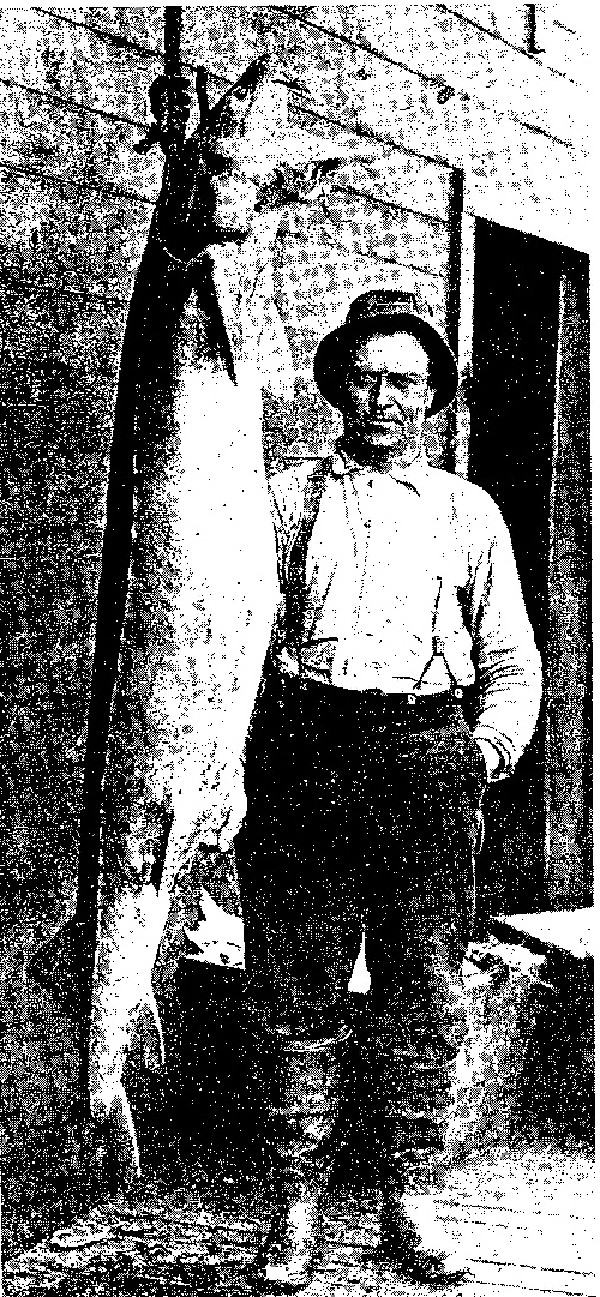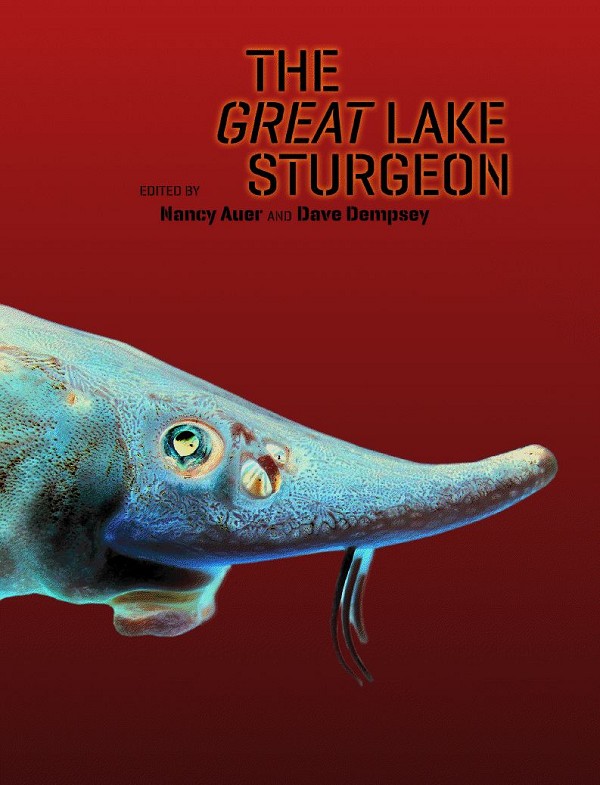STURGEON HERE? Scientists Study Lake Sturgeon Spawning in Saginaw River
|
||||||||||
| Printer Friendly Story View |

Sturgeon caught in Saginaw Bay in 1800s was reportedly 6.5 feet long and weighed 160 pounds. (Bay County Past & Present)

New book due out in June from Michigan State University Press chronicles sturgeon in the Great Lakes.
Are there huge 300 pound sturgeon thrashing around spawning right now in the Saginaw River?
Maybe so, say scientists and fish biologists.
Lake sturgeon in the Great Lakes appear to be on the rebound, reports the U.S. Fish and Wildlife Service.
"Recent sightings and scientific research indicate age-class structure within the current populations. This is a positive sign that natural reproduction is occurring, particularly with the number of juvenile sightings. Although populations are believed to be increasing, they are still impaired with relation to historical abundance."
The Saginaw River is one of 17 rivers in Michigan which historically have supported spawning of lake sturgeon. The fish reportedly migrate upstream to the Tittabawassee and Cass rivers.
Sturgeon six feet long weighing 160 pounds were depicted in "Bay County Past & Present," by George Butterfield, published by the Bay City Public Schools in 1957.
The book also told of Dr. Thomas Palmer of Bay City, traveling north by boat to inoculate the Indians against smallpox in 1869, encountering a school of sturgeon 60-125 pounds each in Saginaw Bay.
Detroit pioneer Bela Hubbard told of catching a giant sturgeon by hand in 1837 while on a geological expedition in Saginaw Bay.
Spawning involves small groups of less than 1,000 adults in each of these rivers, according to the U.S. Fish and Wildlife Service.
Perhaps the small runs are because female lake sturgeon spawn once every 4 to 9 years while males spawn every 2 to 7 years.
Max King of the Great Lakes Echo reported the Black Lake winter sturgeon season that started Feb. 2 this year ended after only four days when the last of a six-fish quota allowed this year was speared.
Gil and Brenda Archambo have a long history of fishing for and preserving lake sturgeon. Both work with Sturgeon for Tomorrow, a Cheboygan-based nonprofit organization devoted to the conservation of a fish that can live more than 70 years and grow to be more than 6 feet long.
Nancy Auer of Michigan Tech and environmentalist author Dave Dempsey have a new book, The Great Lake Sturgeon, which is to be released by Michigan State University Press (June 2013) and will be available for sale through the website www.msupress.org and through bookstores.
"The Great Lakes lake sturgeon was once considered useless, then overfished nearly to extinction," states MSU. "Though the fish is slowly making a comeback thanks to the awareness-raising efforts of Native Americans, biologists, and sturgeon supporters, it remains to be seen if conservation and stewardship will continue to the degree this remarkable animal deserves."
Rehabilitation of lake sturgeon in the Cheboygan River watershed is a cooperative effort involving the DNR, the Black Lake Chapter of Sturgeon for Tomorrow, Michigan State University and Tower-Kleber Limited Partnership.
This year, Claudia Wright of Onaway speared the largest sturgeon at 66 inches and 67 pounds, according to the Department of Natural Resources (DNR).
Lake sturgeon also live in Burt and Mullet lakes in Cheboygan County, but fishing is prohibited there because the species is scarce, according to the DNR, which determines how many of the fish can be caught each year.
The department set a Black Lake harvest rate of 1.2 percent of the sturgeon population for 2013.
Elsewhere in the state, one sturgeon per person can be caught with hook-and-line equipment with no quota.
In Lake St. Clair and the St. Clair River, the season runs from July 16 through Sept. 30; for Otsego Lake, July 16 through March 15; and on the Menominee River from the first Saturday in September through Sept.30, according to DNR.
Although the Archambos say they have great memories of lake sturgeon over the years, they have negative ones as well because the fish is threatened.
In the 1950s and 1960s, poaching was common in Black Lake and elsewhere in the state, Gil Archambo said. "There were poachers that took actual truckloads of them."
In the late 1990s, the state was going to shut the fishery down because of the poaching, said DNR biologist Tim Cwalinski, but the Black Lake community wanted improved management instead.
They said, "Don't close the fishery," said Cwalinski, who is based in Gaylord.
As a result, what used to be a month-long winter fishing season now runs a maximum of four days.
Lake Sturgeon, with the scientific name Acipenser fulvescens, inhabit large river and lake systems primarily in the Mississippi River, Hudson Bay and Great Lakes basins.
By the early 1900's many populations of lake sturgeon throughout their range had been greatly reduced or extirpated as a result of overfishing, habitat loss, construction of dams, and pollution.
Lake sturgeon are listed as either threatened or endangered by 19 of the 20 states within its original range in the United States. This ancient family of fishes has been recognized since the Upper Cretaceous period (136 million years ago), at a time when dinosaurs thrived.
Lake sturgeon are the only sturgeon species endemic to the Great Lakes basin and are the largest freshwater fish indigenous to that system. Lake sturgeon can be considered a near shore, warm water species with water temperature and depth preferences of low 50s to mid-60oF and 15-30 feet, respectively. Lake sturgeon are benthivores, feeding on small invertebrates such as insect larvae, crayfish, snails, clams, and leeches.
Life history characteristics of lake sturgeon are unique with respect to other fishes and are as follows:
sexual maturity in females is reached between 14 and 33 years, most often from 24-26 years; and, 8 to 12 years for males (but may take up to 22 years);
spawning occurs on clean, gravel shoals and stream rapids from April to June in preferred water temperatures of 55-64 F;
female lake sturgeon lay 4,000 to 7,000 eggs per pound of fish;
growth rates are quite variable throughout its range and depend on temperature, food availability, and water quality; and,
the typical life-span of lake sturgeon is 55 years for males and 80-150 years for females.
As a consequence of interrupted spawning cycles, only 10-20 percent of adult lake sturgeon within a population are sexually active and spawn during a given season. After hatching, some young lake sturgeon have been observed to remain in their natal rivers for their first summer of life.
The most accurate, yet biased, representation of the history of Great Lakes lake sturgeon populations is through the use of commercial harvest data. A summary of the catch, by era, is discussed below. Early commercial fisherman (pre-1850) perceived lake sturgeon as a nuisance fish because of fishing gear destruction. This led to their wide-spread slaughter. As the economic importance of this species was later recognized, a targeted commercial fishery intensified by the mid- to late-1800s. For example, during the heavy fishing years from 1879 to 1900, the commercial catch of lake sturgeon in the Great Lakes averaged over 1,814 metric tons (4 million pounds). In 1885, a maximum of 4,901 metric tons (8.6 million pounds) were harvested, of which 2,359 tons (5.2 million pounds) came from Lake Erie.
1900 to 1986 -- From 1900 to the 1970s, little is known about the lake sturgeon populations, except for their continued decline. For example, by the late 1900's, 80% of the lake sturgeon were removed from Lake Erie. Commercial harvest was reported until 1977, but at very low numbers after 1956. In the late 1970's, Canadian commercial operations in Lake Erie reported harvests of 1.36 to 2.27 metric tons (3 to 5 thousand pounds); much reduced from the previous century. In Lake Michigan, commercial harvest was closed in 1929 after the catch declined to only 2000 pounds compared to 3.8 million pounds harvested in 1879.
Factors affecting the decline in lake sturgeon populations include commercial overexploitation, followed by some degree of habitat loss and degradation. Also, the reproductive cycle further complicates recruitment; hence, catalyzing their dramatic decline.
Habitat loss is sure to be a contributing factor to the demise of lake sturgeon. For example, in all the Great Lakes, damming of tributaries prevented access to historical spawning grounds, destruction of spawning areas occurred via siltation from deforestation, agriculture, and dredging, and pollution from nutrient and contaminant loads further hindered reproductive success.
Consequent to the decline, only a remnant population remains today in most Great Lakes areas. As a result of these declines, lake sturgeon are: (U.S.) recognized by the American Fisheries Society as threatened in North America and, listed as Endangered, Threatened, or Special Concern in 19 of 20 states throughout its range. Lake sturgeon are protected in Canadian waters of the Great Lakes with closed seasons, size limits, creel limits, and gear restrictions.
Recently, interest in the restoration of lake sturgeon has increased greatly. The fish can serve as an indicator of ecosystem health and biodiversity, particularly because of its unique life history characteristics. Also, with the addition of zebra and quagga mussels, Dreissena sp., the energy flow is apparently shifting to the benthos. This could support increases in populations of benthic feeding fish such as the native lake sturgeon.
Partnerships have been developed to report lake sturgeon sightings to their respective management agency. Some partnerships allow temporary possession so critical information can be collected from the specimens.
| Printer Friendly Story View |
|
|

Dave Rogers |
|
|
|
Printer-Friendly Story View
0200 Nd: 04-22-2024 d 4 cpr 0
12/31/2020 P3v3-0200-Ad.cfm
SPONSORED LINKS
12/31/2020 drop ads P3v3-0200-Ad.cfm


